What is Emerald Ash Borer?
Emerald ash borer (EAB) is a beetle native to Asia that was introduced to Detroit, MI in 2002. It has destroyed tens of millions of true ash species in over 25 states, including Nebraska. Forests, windbreaks, and urban trees—some 44 million Nebraska ash trees—will be lost in the coming years. Many leading EAB researchers speculate that it has the potential to "functionally" wipe out the ash species with devastating economic and ecological impacts.
Why should I be concerned?
EAB is able to kill all ash trees, regardless of their health, age or size. It has killed hundreds of millions of ash trees already in the U.S. As of October 2018, it was found in several locations in Nebraska: Omaha, Greenwood, Lincoln, Fremont, and Ashland. EAB advancing westward across the state is not up for debate; what is unknown is how many years it will take.
What does EAB look like?
Adults are green beetles approximately one-half inch long with slender bodies. Larvae are cream colored and up to 1 1/4 inch long. Larvae have brown heads and a 10-segmented body with bell-shaped segments near the back end.
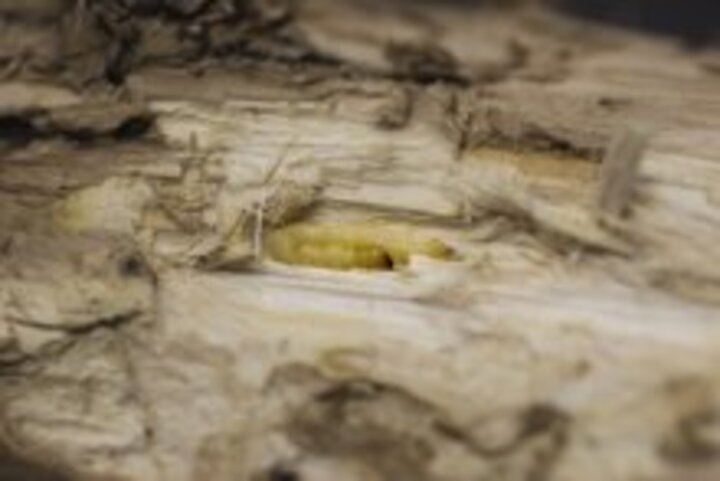
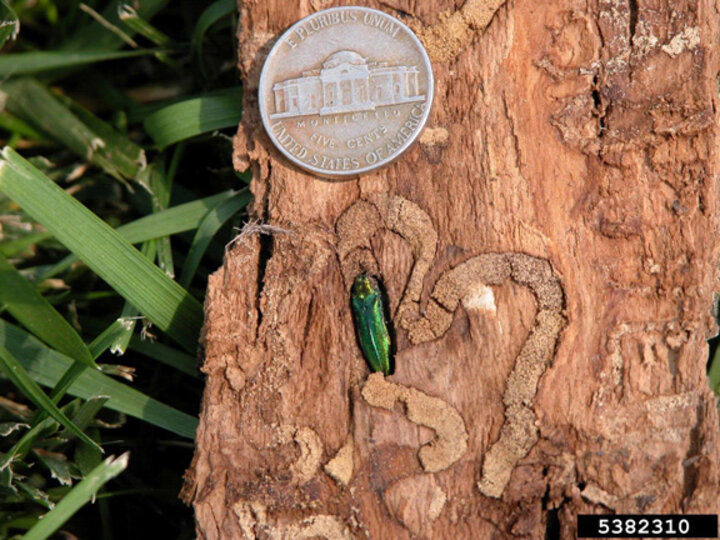

What trees does EAB attack?
EAB attacks and kills all species of North American ash, including white, green and black ash. Common varieties of ash include Patmore, Marshall’s Seedless and Autumn Purple ash. Mountain-ash is not affected because it is not a true ash.
How do I identify an ash tree?
Ash trees have an opposite leaf pattern, which means leaves, buds and stems are located directly across from each other. Ash leaves are compound and typically consist of 5-11 leaflets. When seeds are present, they are paddle-shaped and in clusters that stay on the tree until late fall or early winter.

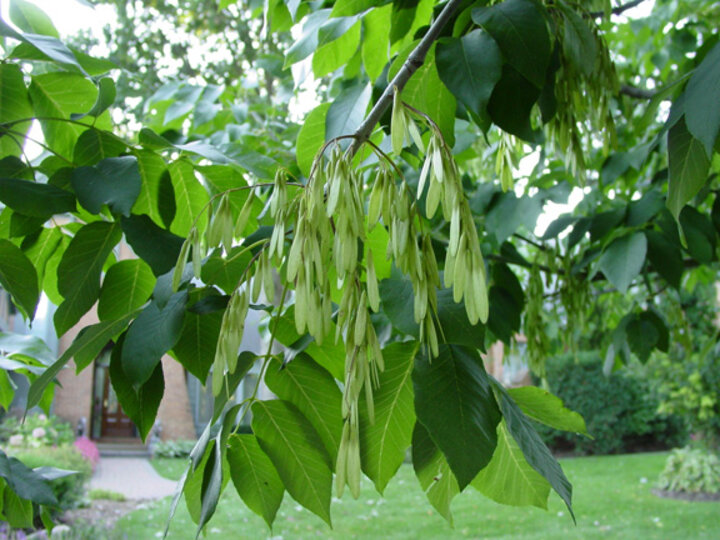
Are there any ash varieties that are resistant to EAB?
Manchurian ash (Fraxinus mandshurica) and its cultivar ‘Mancana’ ash are native to Asia and are resistant. Currently no ash species or cultivar native to North America is resistant.
Where has EAB been detected?
EAB was detected in more than 25 states in the U.S. and two Canadian provinces. In Nebraska, it has been detected in Douglas, Cass, Lancaster, Saunders, and Dodge counties. It has been found also in the neighboring states of Iowa, Missouri, Kansas, and Colorado.
How is EAB spread?
EAB spreads mostly through human-assisted movement, such as moving infested firewood and nursery stock. To prevent the spread, moving firewood and nursery stock out of infested areas is regulated by state and federal quarantines.
What can I do to avoid spreading EAB?
To avoid spreading EAB and other wood-infesting pests, collect or purchase firewood where you will burn it. Don't bring wood with you when you travel. Leave unburned wood at the campsite. Visit www.dontmovefirewood.org for more information.
Should I treat my ash tree?
Treatments should be considered generally only if EAB has been detected within 15 miles of your location and if the trees are in good health and in a good location in the landscape. If your tree has EAB-like symptoms, such as canopy thinning, branch dieback or D-shaped exit holes, have a certified arborist examine the tree. For more information about whether to treat a tree, see the publication Selecting Trees for Emerald Ash Borer Treatments.
What are the treatments for EAB?
One treatment available for use by homeowners is a soil application of imidacloprid (such as Bayer Advanced 12-Month Tree and Shrub Insect Control*). The application should be made in May and is most effective on small trees, generally less than 15 inches in trunk diameter. Tree care professionals are able to use additional products such as trunk injections and trunk and foliage sprays. Contact a certified arborist for these treatments. For more information about treatments, see the publications Emerald Ash Borer Guidelines for Nebraska Homeowners and Emerald Ash Borer Treatment Options.
Should I remove my ash tree before it gets EAB?
If your tree is healthy and in a good location, there is no urgent need to remove it. However, removing a tree somewhat early can have the benefits of providing space and additional time for a replacement tree to grow. It also would eliminate the possible need to remove a tree quickly when it dies, because ash trees become dangerous from falling branches soon after they are killed. If a tree is dying or diseased, it may be best to hire a certified arborist to look at the tree to determine whether it has EAB or a different problem. Holes in the bark and dieback in the canopy can be symptoms of other insect pests, diseases and environmental problems.
Should I continue planting ash trees?
Ash has been a popular tree for landscape, agroforestry and conservation plantings for decades. This popularity has resulted in a tremendous number of ash trees being planted in Nebraska. Because diversity is an important measure of the overall health of a community forest, it is important to plant a variety of trees. Based on this and the threat of EAB, planting ash trees is not recommended. A number of other trees grow well in Nebraska. For recommendations about trees, visit ReTree Nebraska or contact your local Nebraska Forest Service District Forester.
What other insects attack ash trees?
Several species of native borers attack ash trees. The ash/lilac borer, banded ash clearwing and carpenter-worm attack healthy ash trees. The redheaded ash borer, banded ash borer, flatheaded apple tree borer and eastern ash bark beetle attack stressed or dying ash trees. For more information about these insects, see Decline in Ash Trees: Borers & Bark Beetles: An Identification Guide.
Other borers of ash (left to right): ash/lilac borer larva, carpenterworm and ash/lilac borer exit holes. Exit holes for these borers are round and 1/4-inch in diameter or larger.

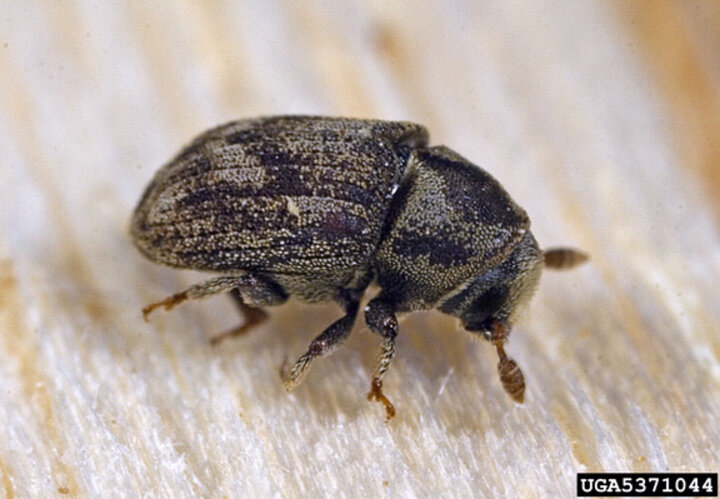

What other insects look like EAB?
Many insects are frequently mistaken for EAB. The six-spotted tiger beetle, golden flatheaded borer, green June beetle and Japanese beetle are often mistaken for EAB. For more information about EAB look-alikes in Nebraska, see Emerald Ash Borer Look-Alikes.
EAB look-alikes (left to right): six-spotted tiger beetle, golden flatheaded borer, green June beetle and Japanese beetle.
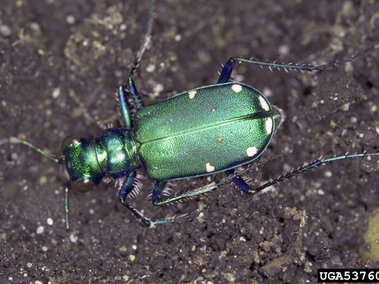

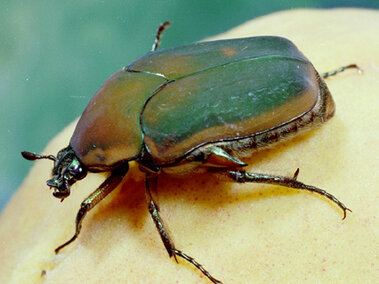
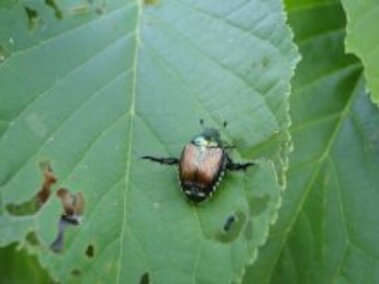
What can be done with wood from trees killed by EAB?
Only limited options are available for treating infested ash wood to ensure EAB will not be spread through lumber or wood products. For more information visit the NFS guide for utilization or contact the Nebraska Department of Agriculture at 402-471-2394.
Who can I call if I think my tree has EAB?
If you think your ash tree has EAB, contact the Nebraska Department of Agriculture at 402-471-2351 or USDA APHIS at 402-896-8256.